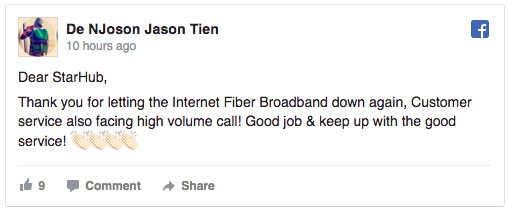SINGAPORE: Customers of StarHub (one of the biggest telco company in Singapore) took to social media to air their frustrations about a second fibre broadband service outage on Monday evening (Oct 24), two days after the first outage.



Would you agree that if we push this 5 years back, this might not be a head news to all of us, since the social media wasn’t so ‘part of our life’ back then?
Similar story like Samsung, a big corporation spend so many years to build up the brand, and because of one quality issue, it failed the whole brand and it might take years for a brand to recover from it or some can’t even stand up again…
This is sad, but this is true, this is true because of the double-edged sword of social media, it’s the nature of social media, we can’t change it, but we need to re-think how we could survive under it.
If you are running an eCommerce business, certainly you don’t want some mistake to happen in your platform/website that causing people’s frustration and take it to the social media… today we will focus on the Quality Assurance, which is the crucial point in the eCommerce process.
We will show you step by step how to do QA for eCommerce
Step 1: Plan it correctly
First and most crucial step is planning. Not all e-commerce systems are built alike; as a matter of fact, most e-commerce systems I have tested vary in a number of ways, including discount processes, promotion code entry, and checkout flows. While one website may require a user to have an account in order to view discounts, another website may allow discounts to anonymous users through promo codes or online savings. It is important to have an understanding of all of the systems integrated into the e-commerce system prior to testing. Will a user need to be logged in to complete purchase? Can they order online as anonymous users? How do these processes differ? A prepared QA resource is aware of all plausible scenarios for a user’s online experience so that no stone goes unturned.
Step 2: Sorting the information
After gathering all relevant user scenarios, we need to do the sorting to it. QA Specialist can have all the knowledge that they need, but if all the information are pieces here and there, it will be difficult for them to identify what test cases need to be executed and when it needs to be executed.
This means that the QA Specialist sorts through all the information provided to them and identifies any integration points and how this will effect testing efforts. I have tested e-commerce systems that upon checkout link to an external client page. Because of integration with external systems, full purchasing cannot always be tested locally, and often needs to happen after the code has been pushed to the Live/Production server. It is important to identify these points prior to testing efforts so that testers do not spend unnecessary time trying to test something that cannot be tested; it also helps the project manager know that they need to inform the client of any risk factors early on. An outline of test cases should be written during the organization phase of e-commerce prep. At the end of this phase, the QA specialist should know on a high level what needs to be tested.
Step 3: Building the test cases
Once all the information is ready and sorted, we need to build the test cases: the basic test cases can be developed based referencing the scope, requirements document, more complex test cases would be based on the user behaviours, these user behaviours can be adapted from the UX specialist who should actually cover these information in their initial design documents.
The QA Specialist should also identify all different customers account scenarios needed for testing purposes, and pass them to the development team to do the preparation before actual testing, this is part of the project manager’s job to make sure all test accounts are set up prior to testing so that QA resource could work on it without waiting
Step 4: Execution
At this step, the QA Specialist already has user scenarios outlined, test cases written, accounts created, so let’s EXECUTE.
Although it may be close to impossible to outline all possible user scenarios, the amount of user scenarios that do not work should be encountered on a minimal basis. The end result of all this should be a happy client and happy customer base.
After all, a thoroughly tested system is needed for every company who doesn’t want to be complained on Social Media!
If you need to find a QA and QC partner for your eCommerce solution, you can check out our QA service page






